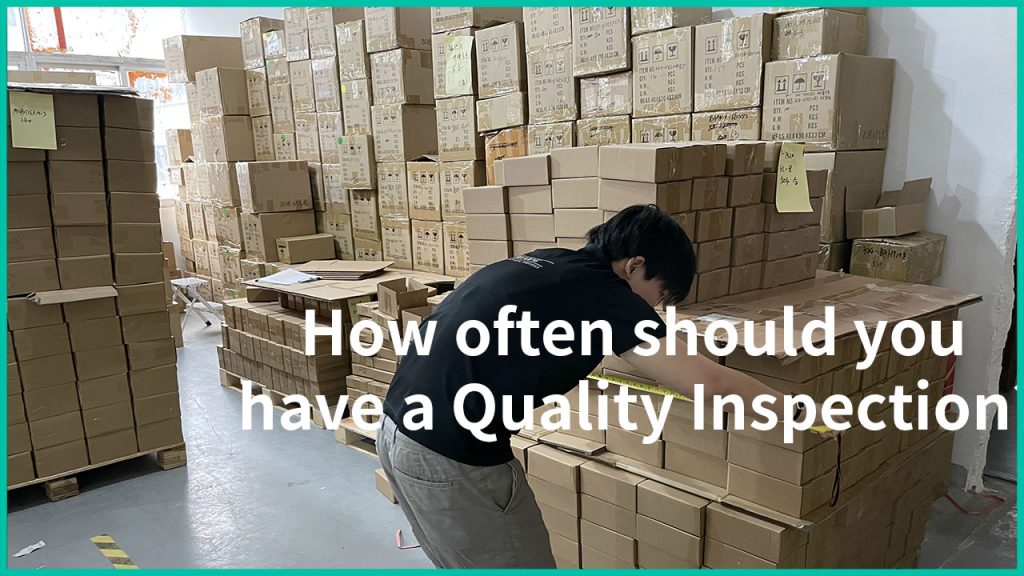How often should you have a Quality Inspection?
It is clear that Quality Inspections are one crucial expense in the importing business. This is why many importers feel concerned about exceeding their budget or wasting their money. If you want to make the most of your time and money, how often should you have a Quality Inspection?
There is no specific “correct” frequency to control your suppliers since every importer has different requirements and standards. This can only depend on how important the quality of your products is for you and your business.
For example: for Amazon resellers, premium quality is a must. Since bad reviews will cause their products to be delisted and lose sales.
There are different ways of conducting a Quality inspection:
· Inspect the same order several times throughout the production process
· Pick and inspect some orders more than others
Convening these different methods, will help you identify the quality issues and make the manufacturing process more efficient!
Quality History with your Supplier
Most importers will work with more than 1 supplier. Depending on your relationship with your suppliers, you will need to conduct more or fewer inspections at their factories.
New Supplier VS Old Supplier?
New suppliers do not have any experience in understanding your quality requirements. That is, they will use their own quality standards. In that case, more inspections will be needed to ensure that the suppliers are on the same wavelength as your business.
Suppliers with whom you have worked for a longer time will be familiar with your quality standards and, generally speaking, will not need as many inspections from your side.
However, it can happen that some suppliers will become too complacent and gradually decline in product quality. This is why you should never stop conducting quality control inspections. Spot checks here and there should be also implemented after working with your supplier.
Results from previous inspections
Results of past inspections are one of the factors to determine the frequency of quality inspections. Such results reflect the actual on-site reality of production, and it is something you can truly rely on, instead of having the supplier promise to improve.
Inspection results reflect the followings:
· AQL defects results which have a clear definition of pass/fail rate
· Classification and types of quality issues
· Feedback provided by the factory on the issues found
· Production and shipping deadlines
Re-inspection is always a good idea for all suppliers in case they fail the previous inspection. This second inspection should focus more on the visual quality and addition sample sizes for on-site tests (Function Tests).
Value of your Product
The value of your product is another factor that will determine the frequency of your inspections. A cost analysis can assist in tabulating the extra costs with either add on inspection cost or forgoing inspection.
We recommend conducting at least one inspection per shipment. This will allows you to find any issue before shipping. That is, to save time and money. For example, if you are sourcing low-value products, such as some types of fabrics, you would only need to rely on a pre-shipment inspection to make sure that the products meet your specification
However, if you are manufacturing high-end products, such as knives or cookware, you will need more inspections to ensure that the products are up to standard. The cost of poor quality would greatly impact your sales. Even though inspecting more frequently will raise your cost at the moment, it will increase your overall revenue!
Nature of your Product
The nature of your products will have a major impact on how frequently you need to have quality inspections done. Delicate and technical products will need more strict control than others since the lack of quality in these could lead to damaging the users’ health. For example, medical devices and kitchenware.
Consumers’ Expectations
Your customer expectations are proportionately related to your marketing. Should you promote your products to high-quality standards and fail to deliver, it will destroy your reputation and customer trust.
How can you avoid this? Deliver what you preach.
Have you marketed your products on quality features? Does your company market itself on quality-oriented value? In that case, you will need to inspect more frequently, in order to ensure that your promises match the product that your consumer will receive.
There are 2 types of consumers in the market – Retail and ecommerce consumers. Each market has its own quality point of standard. You can gather feedback on expectations from these sources and learn how to address these specific issues:
· Refunds
· Complaints
· Online Reviews
After gathering this information, you should inform your suppliers and inspection company, so that they are aware and can improve on the next round. We recommend creating a QC checklist with feedback in addition to the inspection scope meant for your products so that both parties (yourself and the supplier) can be familiar with it.
Working with a Third-Party Inspection company would benefit you even more than sending or hiring your own employee to a station in the manufacturing countries. At the very least, there is no fixed cost, and the inspection schedule can be changed at any time. In this way, you will not be worried about not having enough staff to handle the project. Professional Third-Party Inspection Companies will provide you with multiple options to best meet your budget. Never relax between the inspections, based on each report and feedbacks. The QC checklist should be updated constantly to avoid outdated information.

